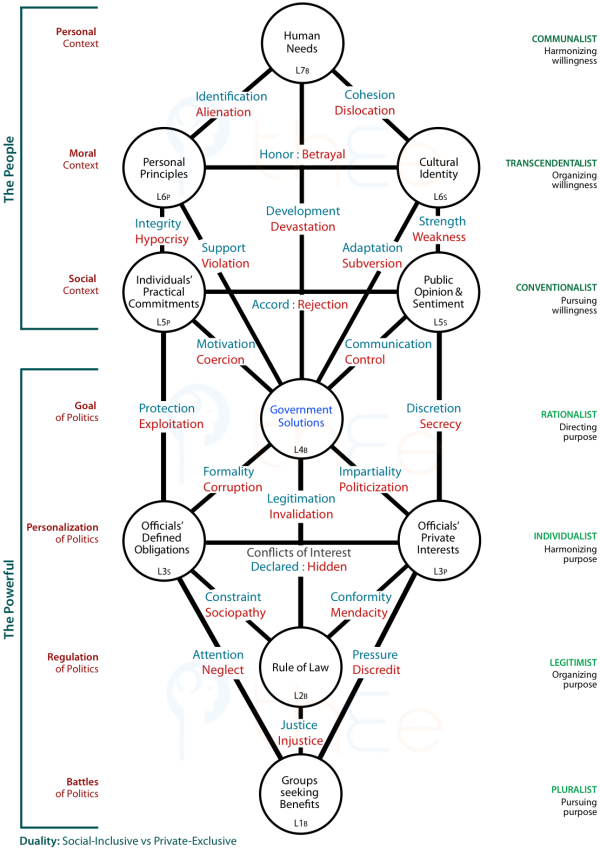Review Determinants of Political Choices
The picture of how the people & the powerful interact to within a society is now complete. The 10 Centres and 22 Channels reflect constant and universal features of politics and government.
This Tree framework deals with choices determined at any point in time. It contrasts with the evolution in maturity of political institutions over time. The features of both the Spiral Modes and Tree Levels are derived from the approaches to ethical choice.

The approaches (Typology), the Modes (Spiral), and the Levels (Tree) have identical formal-names as shown in in the far right-hand column. The maroon labels in the far left-hand column are closer to our everyday experiences.
An appreciation of any factor that is uniquely political depends on recognizing a dynamic duality: the Social (i.e. what is public, inclusive, common, shared) labelled [S] and the Private (i.e. what is personal, exclusive, individual) labelled [P]. These two opposing aspects are applicable at each Level.
The two poles are sharply distinct in three of the Levels (). In the remaining four Levels, () the poles are intrinsically fused.
Lines joining Centres define bi-directional Channels, which represent flows of influence between the Centres. All Centres and all Channels are necessary to fully appreciate the forces that within a society.
No Centre affects all the others. The Centre with the most connections is and, interestingly, this does not connect directly to the in society.
While the states represented by the Centres are ever-present, the Channels may be activated to a greater or lesser degree (or given more or less attention) according to the social issue under consideration.
This occurs because the people do not pursue outcomes for their communities. As a mass, they prefer to pursue their own purposes in private activities. The people do, however, have values which impel them to seek to influence their communities, specifically being concerned with social goods (ie "the public interest") and generally concerned with conformity, continuity and stability.
Those individuals who become part of the powerful do so through developing or joining . These groups necessarily have explicit goals that are self-interested and not necessarily community-oriented. The powerful naturally strive to get changes in society that forward their goals, even if these are not in the public interest.
Compare the links:
- 6 direct links amongst various manifestations of the people
- 7 direct links between aspects of the people and of the powerful
- 8 direct links amongst the various manifestations of the powerful
The model does not describe that are participative as these would need to operate simultaneously on numerous levels:
For example, does not refer to the complicated process by which government makes a choice, but rather specifies a particular solution to a social issue.
Similarly, does not refer to a person applying principles or persuading others, but just specifies the existence of as a genuine force in .
A framework constructed using all the elements of this Tree is required to clarify how and why individuals seek to affect the public and officials, should they choose to do so. This next framework will enable clarity about how the need for change is experienced and developed, both rationally and politically.
Review the total picture as follows:
- Paradoxes of accepting and striving in political choice.
- Politics working superbly or going horribly wrong.
- Societies not yet developed to Stage-2 Legitimism.
- Exploration of political channels.
Then consider some practical applications:
- Politics in organizations.
- How global politics works (or fails to work).
- The politics of family life.
In the next major section of this inquiry, we use the Tree-Levels developed here to map participation in the political life of a society.
Originally posted: July 2009; Last updated: 12 June 2014.